How to choose a mixing console

Sound production at concerts requires a mixer to shape the sound of instruments so they work well together and to balance their ratios so they can all be heard without any single instrument dominating or, conversely, getting lost. And yet, the use of mixing consoles is much broader. DJs require special mixing consoles for their work, they're useful in practice rooms and are also essential for keyboardists with several sound modules and samplers so they can set volume levels on their own. There are several different types of mixing consoles, ranging from the smallest with two or four inputs up to digital consoles with 64, 88 and 168 inputs used by the biggest bands at their concerts. To help you choose the right mixer, we have prepared the following introduction to the individual types.
TIPS FOR BEGINNERS:
If you are looking for a simple mixing console for your sound system for a club or a rehearsal room, a mixer with 10 channels will suffice. These channels will allow you to connect musical instruments, microphones, auxiliary sound sources and more.
Our experts will be happy to help you with your selection of a mixer. Call us at 169 941 99 (Mon-Fri 9:00 a.m. - 4:00 p.m.) or send us your questions by email to .
Basic overview of mixing consoles
Mixers differ by their features. Mixers for DJs must have crossfader to blend a signal from two turntables and equalisers to dynamically change the sound. They also have a different inputs DJ mixers work with stereo signals and must be able to connect turntables, for which they are also equipped with the proper preamps. In contrast, mixers for producing sound at concerts mostly have microphone inputs, which can usually also be used as line inputs. Some models have several extra line inputs, often stereo, to connect a drum machine or some other player. Smaller mixers often also have an amplifier.
Mixing consoles also differ by construction, with both analogue and digital models available; different settings can easily be stored in the memory, which is especially useful at festivals with multiple bands Digital mixers also have a large number of integrated effects for shaping sound, so it isn't necessary to buy various external effects. Thanks to the fact that they can be connected to a computer, mixers can replace a sound card, and they are also useful in recording individual instruments in tracks. The higher price is compensated by a greater number of functions.
Choosing a mixing console
When choosing a mixer, you first need to know what you will use it for and what are your needs:
1 – determining the source of signals (turntables, instruments, microphones)
2 – choosing the type of mixer (for a DJ, with a built-in amp, analogue, digital )
3 – determining the number of channels
4 – channel requirements (number of equaliser bands, input inserts, sole/mute regime
5 – number of effect loops and outputs for stage monitors
6 – number and type of outputs
7 – other requirements (built-in reverb, digital USB output, possibility to connect a music player to the hall before a concert)
Mixing console types
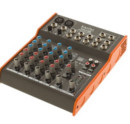
Intended for producing the sound of small groups, e.g. a folk duo, while also being useful for musicians working with electronic music who have multiple instruments. These mixers typically have equalisers on some inputs and usually two aux-sends for connecting external effects.
To save space, they sometimes use rotary controls instead of sliders.
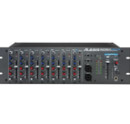
These simple mixers are not set on a table but installed on a rack between other equipment. Keyboardists with multiple sound modules often use them. A low 1U rack-mounted mixer has only rotary controls for volume and panorama; some models also have a single effect loop.
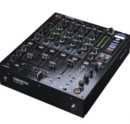
Their basic features are typically two stereo channels to which turntables or other players and controllers are connected. A key element is a crossfader, which allows the DJ to blend two stereo channels. Each channel typically has a 3-band equaliser to significantly strengthen or suppress (even totally eliminate) the given band. However, mixers for advanced DJs can also have multiple channels, and they usually have a mike input. They also differ from other mixers by their inputs. While the majority of mixers use Cannon connectors (XLR) for mikes and jack inputs (TRS), DJ mixers have Cinch connectors for line inputs (RCA).
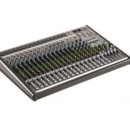
Concert mixers have at least 16, often 24 or 32 fully equipped channels with a 3-band, more often 4-band equaliser and at least two to four aux-sends, two for independent monitor paths and two for effects loops. Better models have at least two to four subgroups that can be used for drums or choirs.
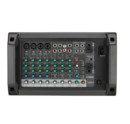
Powered mixers – mixers with a built-in amplifier
Combining a smaller mixer with a built-in amplifier, this device is ideal for smaller performances and rehearsal rooms.
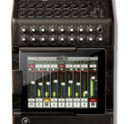
Digital mixing consoles rank among the most modern mixers. Remote control is possible from a tablet, allowing the sound to be shaped and set from various parts of the hall. The other main advantages of digital mixers are various built-in effects, they are smaller and lighter and enable the use of presets, which you can activate with the press of a button.
Mixing console architecture
Each mixing console is made up of three sections: input, mixing and output. Individual signals are sent to the input channels and modified. In the mixing part, individual channels mix and and are assigned to individual outputs. The signal can be further changed in the output part; at the very least, volume is regulated with the control.
The simplest mixing consoles have a basic construction and only permit volume control on each channel and perhaps stereo balance control More advanced models have one control for setting the input level and a slider or rotating control to regulate the volume of the signal, which is then sent to the mixing section. Another control adjusts stereo balance. Each channel is typically equipped with an equaliser.
Higher range mixers are also equipped at least on microphone channels with inserts that allow you after setting the input level to connect external effects to process the signal, e.g. compressors. Some mixers also have simple built-in compressors. In many cases, each channel can also be switched off or switch to solo regime, which is useful when setting the sound.
Also important is a section for controlling the level of the signal sent to individual outputs on SEND connectors. These are use for additional external effects in an effects loop (AUX) and for stage monitor speakers (MON). The number of auxiliary outputs is very important, as it determines the number of independent stage monitor paths and how many separate effects can be connected. Some mixing consoles have built-in reverb effects.
Some are equipped with a USB port, so they can be used to record to a PC and function like a sound card.

